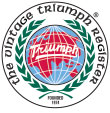Air Shocks for a Triumph Spitfire
Not long ago, when I launched my second Spitfire as a daily driver, I found it too suffered the same malady as other Spitfire 1500s; a sagging rear end. After trying to cure the sag problem on my first Spit with a re-arched rear spring, I finally ended up replacing the OEM Girling rear shocks with a set of Monroe air-adjustable shocks.
By increasing or decreasing the air pressure of these shocks, I not only can increase the load capacity of the trunk (in a Spitfire??) for overnighters, but I can also maintain proper camber angle for normal everyday driving.
My first set of these shocks was installed in 1990 and they’re still working properly. Even though that car is not may daily driver, during warmer months it has been autocrossed on a monthly basis.
Try not to misinterpret the purpose of this modification. although it will help support the rear end, which on a Spitfire is woefully weak, it in not intended to replace a badly worn transverse leaf spring. If the spring is shot, replace it then use these shocks to fine tune.
Another question I hear a lot is why Spitfires always seem to sag more to the drivers side. I have a theory. If you think about it, the average male driver accounts for about 1/10 of the Spitfire’s total rolling weight, that’s always offset to one side. That’s bound to upset the geometry. To check the “set” of your spring, roll the car back and forth on smooth level ground. If the car returns to a fairly normal attitude, the spring is probably still in serviceable condition. If the car maintains a decided list to port, the spring may have taken a set. Swapping the spring end-for-end could extend its life. Once both rear wheels take on that hideous 7-8o negative camber, think about replacement.
The air shocks I’ve used are designed for 1963-82 Corvettes. Their compressed and extended lengths are close to Spitfire OEM, with the air-adjustable units extending about 1-1/2″ longer. The top and bottom mounting eyelets are identical, although a rubber bushing swap will be needed. And best of all, no modification to the car is needed. Both Monroe and Gabriel kits include two shocks, tubing, connectors, routing clips, and inflater “T”.
The Monroe kit number is MA 785. When I spoke to Monroe Customer Service in the Fall of 1995, they had no plans to discontinue this number. Their list price for the kit is about $170. Our local discount auto parts supply could special order the kit for about $88, delivered in 2-3 days.
Good ol’ JC Whitney (312-431- 6102) carries what I believe is the Gabriel cross reference (there are no brand names on the packaging or the white painted shock itself, and Whitney would neither admit or deny the Gabriel connection). Whitney’s catalog number is 81-3388Y. Remember, tell them it’s for a ’63-’82 Corvette (pick a year) or the phone representative will go into a tail- spin trying to figure why you want to order Corvette parts for a Spitfire. Cost is about $75, delivered to the east coast in about 7 days.
When I installed the Monroes, it was necessary to remove both upper and lower bushings and reuse all four of the stock Spitfire rubber cones. The Gabriels come with a lower bushing that slides right onto the stock Spitfire mounting post; the upper bushing needs to be removed and replaced with two stock cones. The Gabriels may also require a thin washer slipped onto the lower mounting post first to provide a little extra clearance from the vertical link (conveniently provided in the kit’s hardware baggie). Hint: A little silicone spray goes a long way in easing re-assembly.
 The air lines that come with either kit are long enough to route just about anywhere you chose. On my latest conversion, I ran the air lines from the shocks, up through the rubber bushings already in place for the fuel (left side) and vapor recovery (right side) lines in the floor of the trunk. In either case allow a little slack for movement.
The air lines that come with either kit are long enough to route just about anywhere you chose. On my latest conversion, I ran the air lines from the shocks, up through the rubber bushings already in place for the fuel (left side) and vapor recovery (right side) lines in the floor of the trunk. In either case allow a little slack for movement.
My “T” filler valve was mounted in a 5/16″ hole I drilled through the top edge of the panel that covers the fuel tank, on the trunk side. Check for kinks and clear routing of the air lines before and while reattaching the panel. Like I said before, the air lines are long enough to route just about anywhere; put the “T” valve where it’s convenient for you.
That about it for installation. After lowering the car off the jack stands, take a peek from below to check for reasonable slack in the air lines. In both my Monroe and Gabriel installations, I’ve had no clearance problems with brake lines or vertical links. However, with the addition of various aftermarket parts, clearances may change. Check it!
Both of my Spitfires carry about 45 psi for everyday driving and about 55 psi for road trips with luggage and a passenger. If you want to get fancy, you could adapt individual Schraeder valves for each side and really fine tune your camber. Just add a little pressure to raise the rear, and bleed a little pressure to lower it.
